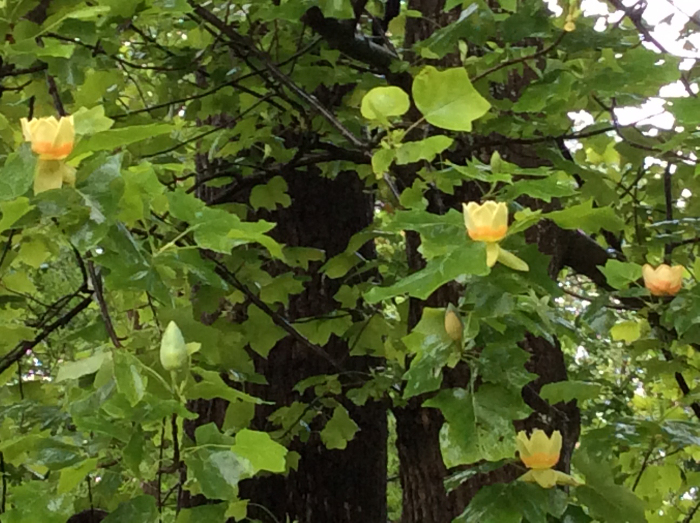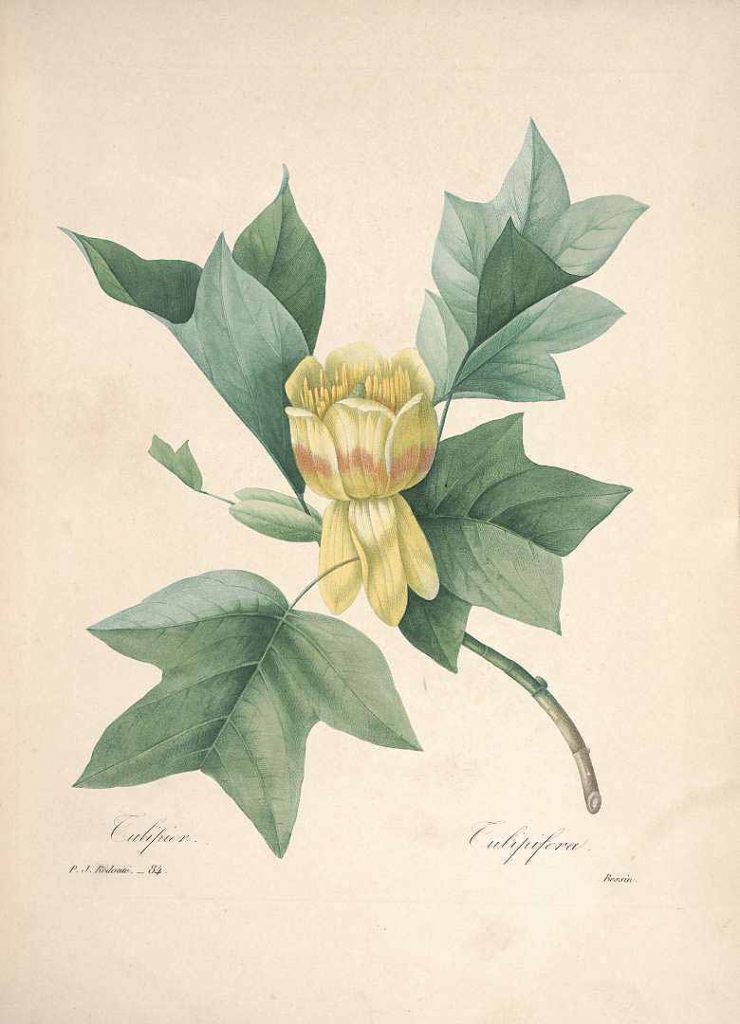
05.22.20 Tulipfest
 One of the most spectacular flower shows of the Appalachian forest is hardly noticed by humans. It occurs above our heads, high in the leaves of tulip poplars, Liriodendron tulipifera. This magnificent tree is the soldier sentinel of the Appalachian forest. It is responsible for the return of woodlands to an area denuded by the logging and farming of European colonists. It grows rapidly, filling in sunny gaps in the forest with cathedral-like groves of stately columns. A rapid grower, it can reach forty feet in just fifteen years! In late spring it shows off with a grand display of tulip-like flowers. We may miss this bloom, but the insects and nectar-loving hummingbirds don’t. These trees produce tremendous amounts of nectar, one flower providing enough for the single trip of a honey bee. Aphids and scale love this sticky juice and extract it, dropping their excrement—known as honeydew—on everything unlucky enough to park below. Tulip poplar is our tallest eastern hardwood and produces a fine, even-grained, lumber of moderate hardness. It’s name is inaccurate, as it is of no relation to true poplars like aspens and cottonwoods. It is the constant fluttering of its uniquely-shaped leaves which probably account for its comparison to these western trees.
One of the most spectacular flower shows of the Appalachian forest is hardly noticed by humans. It occurs above our heads, high in the leaves of tulip poplars, Liriodendron tulipifera. This magnificent tree is the soldier sentinel of the Appalachian forest. It is responsible for the return of woodlands to an area denuded by the logging and farming of European colonists. It grows rapidly, filling in sunny gaps in the forest with cathedral-like groves of stately columns. A rapid grower, it can reach forty feet in just fifteen years! In late spring it shows off with a grand display of tulip-like flowers. We may miss this bloom, but the insects and nectar-loving hummingbirds don’t. These trees produce tremendous amounts of nectar, one flower providing enough for the single trip of a honey bee. Aphids and scale love this sticky juice and extract it, dropping their excrement—known as honeydew—on everything unlucky enough to park below. Tulip poplar is our tallest eastern hardwood and produces a fine, even-grained, lumber of moderate hardness. It’s name is inaccurate, as it is of no relation to true poplars like aspens and cottonwoods. It is the constant fluttering of its uniquely-shaped leaves which probably account for its comparison to these western trees.
 P.J. Redoute’s engraving of a tulip poplar published in 1833.
P.J. Redoute’s engraving of a tulip poplar published in 1833.
 Josef Beery
Josef Beery One of the most spectacular flower shows of the Appalachian forest is hardly noticed by humans. It occurs above our heads, high in the leaves of tulip poplars, Liriodendron tulipifera. This magnificent tree is the soldier sentinel of the Appalachian forest. It is responsible for the return of woodlands to an area denuded by the logging and farming of European colonists. It grows rapidly, filling in sunny gaps in the forest with cathedral-like groves of stately columns. A rapid grower, it can reach forty feet in just fifteen years! In late spring it shows off with a grand display of tulip-like flowers. We may miss this bloom, but the insects and nectar-loving hummingbirds don’t. These trees produce tremendous amounts of nectar, one flower providing enough for the single trip of a honey bee. Aphids and scale love this sticky juice and extract it, dropping their excrement—known as honeydew—on everything unlucky enough to park below. Tulip poplar is our tallest eastern hardwood and produces a fine, even-grained, lumber of moderate hardness. It’s name is inaccurate, as it is of no relation to true poplars like aspens and cottonwoods. It is the constant fluttering of its uniquely-shaped leaves which probably account for its comparison to these western trees.
One of the most spectacular flower shows of the Appalachian forest is hardly noticed by humans. It occurs above our heads, high in the leaves of tulip poplars, Liriodendron tulipifera. This magnificent tree is the soldier sentinel of the Appalachian forest. It is responsible for the return of woodlands to an area denuded by the logging and farming of European colonists. It grows rapidly, filling in sunny gaps in the forest with cathedral-like groves of stately columns. A rapid grower, it can reach forty feet in just fifteen years! In late spring it shows off with a grand display of tulip-like flowers. We may miss this bloom, but the insects and nectar-loving hummingbirds don’t. These trees produce tremendous amounts of nectar, one flower providing enough for the single trip of a honey bee. Aphids and scale love this sticky juice and extract it, dropping their excrement—known as honeydew—on everything unlucky enough to park below. Tulip poplar is our tallest eastern hardwood and produces a fine, even-grained, lumber of moderate hardness. It’s name is inaccurate, as it is of no relation to true poplars like aspens and cottonwoods. It is the constant fluttering of its uniquely-shaped leaves which probably account for its comparison to these western trees. P.J. Redoute’s engraving of a tulip poplar published in 1833.
P.J. Redoute’s engraving of a tulip poplar published in 1833.